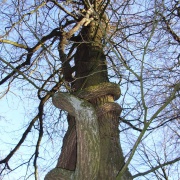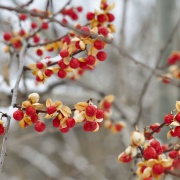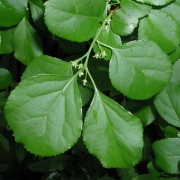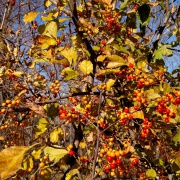Invasive in the Spotlight: Oriental Bittersweet
Oriental Bittersweet (Celastrus orbiculatus) is a deciduous, woody, perennial vine native to China, Japan and Korea, that was brought to this country in the mid-1800s as an ornamental plant. Bittersweet is now considered a serious invasive species because is poses a significant threat to native plants.
Bittersweet vines have alternate, glossy, round or oval leaves that are 2-5” long. The roots are a distinctive orange color, while the vines are light to medium brown with a white pith. Bittersweet has small, greenish-yellow, five-petaled flowers, which produce green fruit in early summer that ripens to yellow and orange by the fall. The plant’s stems and bright fruits are often cut in the fall and used for decoration which can contribute to further spread of this invasive plant. Birds are also quite adept at “planting” new bittersweet vines. Many bird species enjoy eating bittersweet fruit and distribute the seeds to new areas in their droppings.
Oriental Bittersweet can be found in grasslands, woodlands, marsh edges and along road sides. It is often found in open, sunny sites, but its tolerance for shade allows it to invade forested areas as well. It is an extremely aggressive vine that climbs on other vegetation, restricting its host plant’s access to sunlight, nutrients and water. The added weight of bittersweet vines also makes trees and other plants more vulnerable to storm damage.
Control
If the bittersweet infestation is light, hand-pulling vines can be effective, especially before the vines have fruited. Place vines in plastic trash bags and dispose of them, or bake the vines in the sun on a tarp or on a paved surface to kill the roots and seeds. Bittersweet often resprouts from root fragments, so use care to remove as many roots as possible to avoid regrowth.
Heavier infestations may be controlled by cutting stems and painting them with an herbicide in early summer through winter.
Always use an Integrated Pest Management Approach.
Native Alternative
If you love the look of bittersweet in your garden, consider planting native, American bittersweet (Celastrus scandens). American bittersweet can be used in floral arrangements in much the same way as oriental bittersweet.
Photos

Picture by Zefram on Wikipedia Commons

Picture by Esteve Conaway on Flickr

Leslie J. Mehrhoff, University of Connecticut, Bugwood.org

UNH Cooperative Extension Master Gardener volunteers share information about home, yard, and garden topics with the people of New Hampshire. Got questions? Master Gardeners provide practical help finding answers to your questions through the Ask UNH Extension Infoline. Call toll free at 1-877-398-4769, Monday to Friday, 9 a.m. to 2 p.m., or e-mail us at answers@unh.edu.
Related Resource(s)

